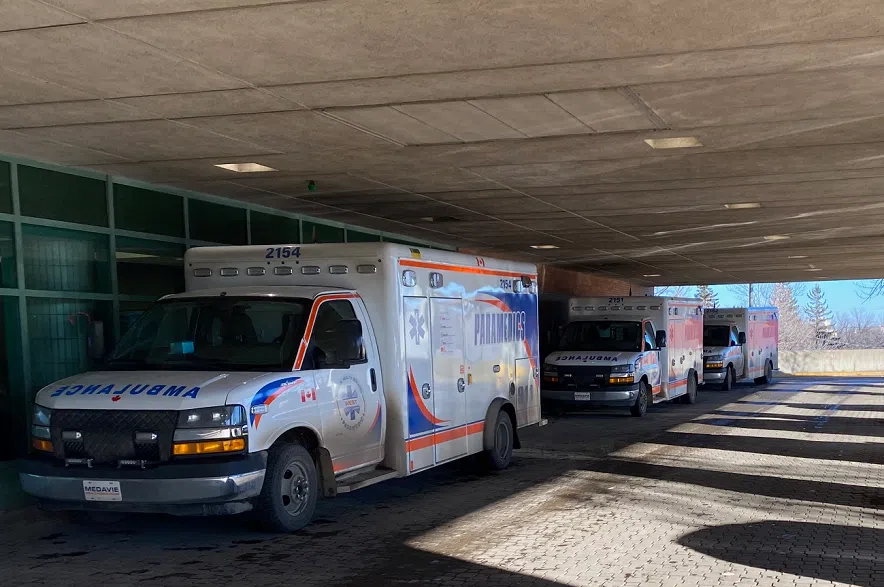The Saskatchewan Union of Nurses says overcrowding at St. Paul’s Hospital in Saskatoon became so unmanageable Monday that a “stop the line” call was made after a patient had a life-threatening incident occur in the waiting room, and no one was able to immediately give that patient a bed.
SUN president Tracy Zambory says “stop the line” essentially means that a situation has deteriorated to the point that patient safety is in question. It gives an employee the ability to stop working until the situation becomes either stable or safe once again, although she noted that nurses never actually stopped working.
“What it did was it sent a very clear signal to management and to Occupational Health and Safety that (there) was a dire situation taking place in the emergency room at St. Paul’s Hospital and someone needed to come — people need to come — and try to figure out an intervention or plan,” she said.
Zambory said overcrowding at St. Paul’s Hospital and at other hospitals — including Regina’s General Hospital — is not a new phenomenon, although the type of call at St. Paul’s Hospital was.
She also said it was not a staffing issue at the hospital.
“There was just far too many patients for (the staff) to manage and they felt like patient safety was at extreme risk,” she added.
What ended up happening was that managers were called in to help with triage.
“Part of the fix was putting more beds in the hallway,” she said, noting the situation continued into Tuesday. “While there were some measures taken, the measures that were taken our members felt were still extremely unsafe, put patients at risk, and put staff at risk.”
According to the Saskatoon Fire Department — which has previously been called out to St. Paul’s for fire code issues — the SFD again received the first call about overcrowding at 1 a.m. Monday.
Three additional calls were made over the next couple of hours, according to a statement from the fire department.
“The SFD Fire Investigator attended and learned the emergency room was full, and this was causing an overflow of extra beds to be located in the hallway. The Investigator identified that both sides of the hallway were being used at the time to host patients and worked with the staff on scene to use only one side as a temporary solution,” read the statement.
No tickets or citations were issued.
Zambory said a Saskatchewan Health Authority action plan announced in November isn’t working.
“The action plan has not translated as (the SHA) said it would to the front lines. It has not,” she said.
SHA responds
According to the SHA’s John Ash — the vice-president for Integrated Saskatoon Health — a “stop the line” call was never made.
“The process that was followed two days ago … was an Occupational Health and Safety process where staff indicated they were not working in a safe environment, so it was not a ‘stop the line’ process,” Ash said, “notwithstanding that it was specific to our nurses in the triage area and this was in relation to their ability to be able to place patients in a bed as they needed.”
Ash noted that employees are encouraged to report to their managers if or when they feel there’s an unsafe situation.
He did admit it was a “unique” situation, though.
“I think the situation that we experienced this week was unique in that we had (an) Occupational Health and Safety process initiated. Certainly that’s the first time I’m aware of that process,” he said.
However, he also said that managers, directors and other leadership teams are actually operationally supporting the day-to-day delivery of care in emergency departments every day.
“As with any emergency department, whether that’s here or in other areas, there are times when we have higher capacity or patients presenting to the emergency department,” he added.
He said the Saskatoon capacity action plan developed in November is starting to work, and right now, with more people visiting hospitals and ERs because of seasonal viruses compared to last year, there’s less sustained overcrowding.
“The continued work that we have outlined in the plan will progress and will ultimately provide some better capacity in the community and more broadly in our continued care areas to support … (so) patients can access the right level of care in the right environment,” he said.
That’s little comfort to Zambory, who said patient and staff care and safety is at risk.
“The emergency room is like the canary in the coal mine. And it’s showing us … that our health-care system is in a freefall,” she said.







